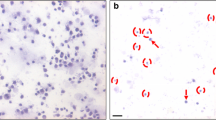Abstract
Diethylstilbestrol (DES), a synthetic estrogen, was examined for genotoxicity in mouse testicular Sertoli TM4 cells using an in vitro micronucleus assay and microarray analysis to clarify the molecular mechanisms underlying the genotoxicity of estrogenic compounds on the male reproductive system. The micronucleus test showed that DES induced genotoxic effects on TM4 cells with S9 activation. Gene expression profiles were studied in DES-treated cells and positive controls, which were cyclophosphamide (CPA)-treated TM4 cells, as compared to the negative controls. In total, 349 and 328 genes were identified as being either up- or down-regulated, with over 2-fold changes, in DES- and CPA-treated TM4 cells, respectively. Biofunction and canonical pathways of differentially expressed genes were analyzed using Ingenuity Pathways Analysis, which were mainly categorized as cellular development and growth/proliferation. In addition, genes related to cell cycle regulation, such as Egr1, Far1, Cd44, Wint16, Sox6, Sox14, Dnmt3a, and Hdac11, were differentially expressed in DES-treated TM4 cells. A gene network analysis was also performed. Comprehensive gene expression profiling of DES-treated TM4 cells provides valuable information to better understand the genotoxic events of estrogenic chemicals in testicular Sertoli cells.
Similar content being viewed by others
References
Tayama, S., Nakagawa, Y. & Tayama, K. Genotoxic effects of environmental estrogen-like compounds in CHO-K1 cells. Mutat. Res. 649, 114–125 (2008).
Danzo, B.J. Environmental xenobiotics may disrupt normal endocrine function by interfering with the binding of physiological ligands to steroid receptors and binding proteins. Environ. Health Perspect. 105, 294–301 (1997).
White, R., Jobling, S., Hoare, S.A., Sumpter, J.P. & Parker, M.G. Environmentally persistent alkylphenolic compounds are estrogenic. Endocrinology 135, 175–182 (1994).
Clark, J.H., Schrader, W.T. & O’Malley, B.W. Mechanism of action of steroid hormone. TEXTBOOK of ENDOCRINOLOGY pp.35–90 (1992).
Hess, R.A. et al. A role for oestrogens in the male reproductive system. Nature 390, 509–512 (1997).
Hess, R.A. et al. Estrogen receptor (alpha and beta) expression in the excurrent ducts of the adult male rat reproductive tract. J. Androl. 18, 602–611 (1997).
Sharpe, R.M. Do males rely on female hormones? Nature 390, 447–448 (1997).
Visser, J.A. et al. Effect of prenatal exposure to diethylstilbestrol on Müllerian duct development in fetal male mice. Endocrinology 139, 4244–4251 (1998).
Sharpe, R.M. et al. Abnormalities in functional development of the Sertoli cells in rats treated neonatally with diethylstilbestrol: a possible role for estrogens in Sertoli cell development. Biol. Reprod. 59, 1084–1094 (1998).
Honma, M. et al. Evaluation of the mouse lymphoma tk assay (microwell method) as an alternative to the in vitro chromosomal aberration test. Mutagenesis 14, 5–22 (1999).
Myhr, B.C. & Caspary, W.J. Chemical mutagenesis at the thymidine kinase locus in L5178Y mouse lymphoma cells: results for 31 coded compounds in the National Toxicology Program. Environ. Mol. Mutagen. 18, 51–83 (1991).
Mitchell, A.D., Rudd, C.J. & Caspary, W.J. Evaluation of the L5178Y mouse lymphoma cell mutagenesis assay: intralaboratory results for sixty-three coded chemicals tested at SRI International. Environ. Mol. Mutagen. 12, 37–101 (1988).
Chung, H. et al. Comprehensive analysis of differential gene expression profiles on carbon tetrachlorideinduced rat liver injury and regeneration. Toxicol. Appl. Pharmacol. 206, 27–42 (2004).
Lim, J.S. et al. Effects of phalloidin on hepatic gene expression in mice. Int. J. Toxicol. 26, 213–220 (2007).
Oda, H. et al. Microarray analysis of the genes induced by tetracycline-regulated expression of NDRF/NeuroD2 in P19 cells. Biochem. Biophys. Res. Commun. 335, 458–468 (2005).
Powell, C.L. et al. Phenotypic anchoring of acetaminophen-induced oxidative stress with gene expression profiles in rat liver. Toxicol. Sci. 93, 213–222 (2006).
Ellinger-Ziegelbauer, H., Stuart, B., Wahle, B., Bomann, W. & Ahr, H.J. Comparison of the expression profiles induced by genotoxic and nongenotoxic carcinogens in rat liver. Mutat. Res. 575, 61–84 (2005).
Kramer, J.A. et al. Acute molecular markers of rodent hepatic carcinogenesis identified by transcription profiling. Chem. Res. Toxicol. 17, 463–470 (2004).
Ibáñez, C.F., Ilag, L.L., Murray-Rust, J. & Persson, H. An extended surface of binding to Trk tyrosine kinase receptors in NGF and BDNF allows the engineering of a multifunctional pan-neurotrophin. EMBO J. 12, 2281–2293 (1993).
Jelinek, T., Dent, P., Sturgill, T.W. & Weber, M.J. Ras-induced activation of Raf-1 is dependent on tyrosine phosphorylation. Mol. Cell. Biol. 16, 1027–1034 (1996).
Author information
Authors and Affiliations
Corresponding author
Rights and permissions
About this article
Cite this article
Oh, JH., Kim, S.J., Kim, JY. et al. Genotoxic effects of diethylstilbestrol on mouse Sertoli TM4 cells using gene expression profiling. BioChip J 4, 49–56 (2010). https://doi.org/10.1007/s13206-010-4108-x
Received:
Accepted:
Published:
Issue Date:
DOI: https://doi.org/10.1007/s13206-010-4108-x




